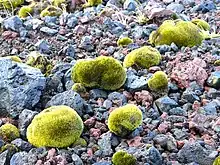Glacier mice
Glacier mice are colonies of mosses found on some glaciers and adjacent ecosystems. They are composed of multiple species of moss[1] and can also host other species, such as nematode worms, springtails, and water bears.[2] Although what preconditions are necessary for glacier mice to form has yet to be determined, they have been observed in Alaska, Chile, Greenland, Iceland, Svalbard, Uganda and Venezuela, as well as several Subantarctic islands.[3][4][5] In at least some cases, glacier mice apparently reproduce asexually due to the effect of the harsh glacier environment on traditional moss reproduction strategies.[6]

Glacier mice are notable for their movement across the ice, which appears to be non-random, taking the form of herd-like behavior. This movement is as yet unexplained,[1] and does not appear to be solely the product of wind or the direction of a slope. On average, they move about 2.5 cm (0.98 in) per day.[7] The use of accelerometers has demonstrated that glacier mice do in fact rotate and roll, rather than simply sliding across the ice, over time exposing all of their surfaces.[7] Measurements of glacier mice show that they retain heat and moisture, creating a suitable ecosystem for microorganisms that otherwise could not live on a glacier.[8][9] Glacier mice are believed to persist for six years or longer.[7]
Glacier mice were first described in 1950 by Icelandic meteorologist Jón Eyþórsson, who referred to them as jökla-mýs, which is Icelandic for "glacier mice."[10]
References
- Greenfieldboyce, Nell (2020-05-09). "Herd Of Fuzzy Green 'Glacier Mice' Baffles Scientists". NPR. Retrieved 2020-05-25.
- Hausheer, Justine E. (January–February 2013). "Curious 'Mice' Thrive on Glaciers". Audubon. Retrieved 2020-05-25.
- Dickson, James H.; Johnson, Robert E (2014). "Mosses and the beginning of plant succession on the Walker Glacier, southeastern Alaska". Lindbergia. 37 (2): 60–65. doi:10.25227/linbg.01052. S2CID 133983103.
- Perez, Francisco L. (1991). "Ecology and Morphology of Globular Mosses of Grimmia longirostris in the Paramo de Piedras Blancas, Venezuelan Andes". Arctic and Alpine Research. 23 (2): 133–148. doi:10.2307/1551378. JSTOR 1551378.
- Uetake, Jun; Tanaka, Sota; Hara, Kosuke; Tanabe, Yukiko; Samyn, Denis; Motoyama, Hideaki; Imura, Satoshi; Kohshima, Shiro (17 November 2014). "Novel Biogenic Aggregation of Moss Gemmae on a Disappearing African Glacier". PLOS ONE. 9 (11): e112510. Bibcode:2014PLoSO...9k2510U. doi:10.1371/journal.pone.0112510. PMC 4234412. PMID 25401789.
- Gao, Fei (2016-04-21). "On Glaciers, Moss Become Asexual". GlacierHub. Retrieved 2020-05-25.
- Hotaling, Scott; Bartholomaus, Timothy C.; Gilbert, Sophie L. (2020). "Rolling Stones Gather Moss: Movement and Longevity of Moss Balls on an Alaskan Glacier". Polar Biology. 43 (6): 735–744. doi:10.1007/s00300-020-02675-6. ISSN 0722-4060. S2CID 218653483.
- Kaplan, Matt (2012-08-27). "On Glaciers, Balls of Dust and Moss Make a Cozy Home". The New York Times. New York City, New York. Retrieved 25 May 2020.
- Coulson, S.J.; Midgley, N.G. (2012). "The role of glacier mice in the invertebrate colonization of glacial surfaces; the moss balls of the Falljökull, Iceland" (PDF). Polar Biology. 35 (11): 1651–1658. doi:10.1007/s00300-012-1205-4. S2CID 18751290.
- Eythórsson, Jón (1951). "Jökla-mýs". Journal of Glaciology. 1 (9): 503. doi:10.3189/S0022143000026538.
External links
- Coulson, S.J.; Midgley, N.G. (2012). "The role of glacier mice in the invertebrate colonization of glacial surfaces; the moss balls of the Falljökull, Iceland" (PDF). Polar Biology. 35 (11): 1651–1658. doi:10.1007/s00300-012-1205-4. S2CID 18751290.
- Belkina, Olga A.; Vilnet, Anna A. (2015). "Some aspects of the moss population development on the Svalbard glaciers". Czech Polar Reports. 5 (2): 160–175. doi:10.5817/CPR2015-2-14.
- Hotaling, Scott; Bartholomaus, Timothy C.; Gilbert, Sophie L. (2020). "Rolling stones gather moss: movement and longevity of moss balls on an Alaskan glacier". Polar Biology. 43 (6): 735–744. doi:10.1007/s00300-020-02675-6. S2CID 218653483.
- The Natural History Museum, London: The secret world of glacier mice on YouTube